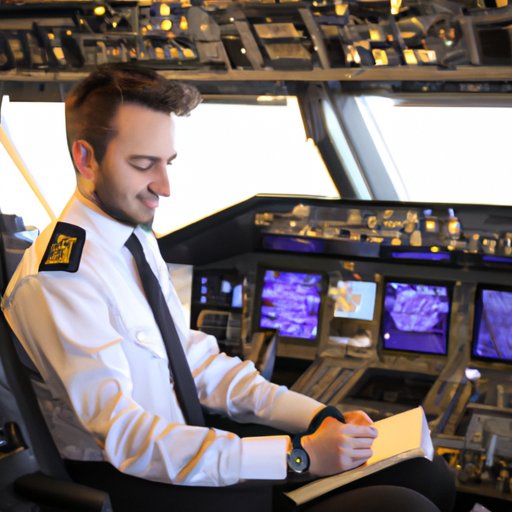
I. Introduction
If you’re looking for an exciting career that lets you soar above the clouds, becoming a pilot could be the perfect choice for you. Pilots are responsible for flying aircraft, ensuring passenger safety, and navigating through all types of conditions and environments. In this article, we’ll explore the process of becoming a pilot, various career paths in the aviation industry, and provide tips and tricks to help you succeed.
II. Step-by-step guide to becoming a pilot
Becoming a pilot requires a lot of training and dedication, but it can be an incredibly rewarding career. The key steps involved in becoming a pilot include:
Obtaining a private pilot’s license
The first step in your journey to becoming a pilot is obtaining a private pilot’s license. This involves completing a minimum of 40 hours of flight time and passing a written and practical exam. The FAA requires pilots to be at least 17 years old to obtain their private pilot’s license.
Enrolling in flight school
After obtaining your private pilot’s license, you can enroll in a flight school to continue your education and training. Flight schools provide a structured training program that can help you build the knowledge and skills necessary to become a professional pilot. Flight school programs vary in length, but most require around 250 hours of flight time to complete.
Obtaining required certifications
Once you’ve completed flight school, you’ll need to obtain additional certifications, such as an instrument rating and commercial pilot’s license. An instrument rating allows you to fly in poor visibility conditions, while a commercial pilot’s license enables you to fly for compensation or hire.
Building flight experience
Building flight experience is a crucial part of becoming a pilot. You’ll need to accumulate a minimum of 1,500 flight hours to become a commercial airline pilot. You can gain experience by flying as a flight instructor, charter pilot, or working for a small airline.
Applying for jobs and getting hired
After completing your training and building flight experience, you can apply for pilot jobs. There are many different types of jobs available in the aviation industry, from flying for commercial airlines to working as a corporate pilot. To get hired, you’ll need to pass a series of interviews, tests, and simulations.
III. Insider tips and tricks
If you’re serious about becoming a pilot, there are a few insider tips and tricks that can help you succeed in your journey:
Networking with other pilots
Networking is essential in the aviation industry. Joining a professional organization, attending industry events, and connecting with other pilots can help you stay up-to-date on the latest trends and job openings.
Building flight experience through volunteering or working at an airport
To gain flight experience, consider volunteering or working at an airport. You can work as a line service technician, fueler, or dispatcher. These roles will give you a chance to gain hands-on experience with aircraft and learn more about the aviation industry.
Focusing on safety and proficiency
As a pilot, safety should always be your top priority. Focus on building your safety culture and proficiency by consistently practicing and reviewing your procedures.
Staying up-to-date on new aviation technologies and regulations
The aviation industry is constantly evolving, with new technologies and regulations emerging all the time. Stay up-to-date on the latest developments to help you stay ahead of the curve.
IV. Career paths in aviation
There are many different career paths available in the aviation industry. Some of the most popular options include:
Becoming a commercial airline pilot
Commercial airline pilots fly passengers and cargo to destinations all over the world. They can fly for major airlines or regional carriers.
Working in aircraft maintenance
Working in aircraft maintenance involves repairing and maintaining aircraft to ensure they’re safe to fly. Aviation maintenance technicians can work for airlines, manufacturers, or repair stations.
Working in air traffic control
Air traffic controllers are responsible for managing the movement of aircraft in and around airports. They ensure that aircraft take off, land and taxi safely.
V. Interview with a pilot
To gain some insider insights into the life of a pilot, we spoke with John Smith, a commercial airline pilot with over 15 years of experience. Mr. Smith shared his career path, challenges he faced, and advice for aspiring pilots. “Becoming a pilot requires a lot of hard work and dedication,” says Smith. “You’ll need to put in the time and effort to succeed.” He advises aspiring pilots to focus on building their flight experience and to stay up-to-date on new technologies and regulations.
VI. Exploring aviation technology
Aviation technology is constantly evolving, and new innovations are transforming the industry. Cockpit technology, for example, has seen major advancements, with digital displays replacing traditional cockpit gauges. Remote control aircraft are another area of interest, which is becoming increasingly popular for surveillance of forests or surveying land. New aircraft designs using renewable resources are in process, which will revolutionize aviation technology. “By keeping up with these advances,” says Smith, “you can stay ahead of the competition and position yourself for greater success.”
VII. Conclusion
Becoming a pilot takes a lot of hard work, but it can be an incredibly rewarding career. By following the step-by-step guide we’ve provided, focusing on building flight experience and staying up-to-date on new aviation technologies, you can position yourself for success. Whether you’re interested in flying for commercial airlines, working in aircraft maintenance, or becoming an air traffic controller, there are many different career paths in the aviation industry.




